THE AIRPORTS
SOUTHWEST
HOUSTON INTERCONTINENTAL AIRPORT
IAH
| As one of the fastest growing cities in the United States, Houston had relied on its city close, Houston International Airport (later renamed William P. Hobby Airport) for airline service since 1938. Realizing that the existing airport had limited room for expansion and lengthening of runways, a group of businessman purchased 3,100 acres north of the the city center in 1957 for a future airport. With the need for a larger airport looming, the City of Houston purchased the property as well as additional acreage to start construction of a new "intercontinental" airport. Construction started in 1965, however cost overruns, and construction woes pushed the opening of the airport into 1969. With a final cost of $110 million, Houston Intercontinental Airport (IAH) started operations on June2, 1969. All airlines that had been using the existing downtown Houston Hobby airport moved their operations to the new spacious and expanded facility. The new airlines moved to IAH included; American Airlines Braniff International Airways, Continental Airlines, Delta Airlines, Eastern Airlines, National Airlines, Pan American Airlines, Trans-Texas Airways, KLM Royal Dutch Airlines, and Aeronaves de Mexico. With intercontinental airport now open, Houston Hobby lost all of its scheduled airline service for a few years. With modern terminal facilities and room for expansion, Houston Intercontinental Airport continued to grow and especially after deregulation in 1978, saw airlines from both domestic and international carriers start service to the Houston region. |
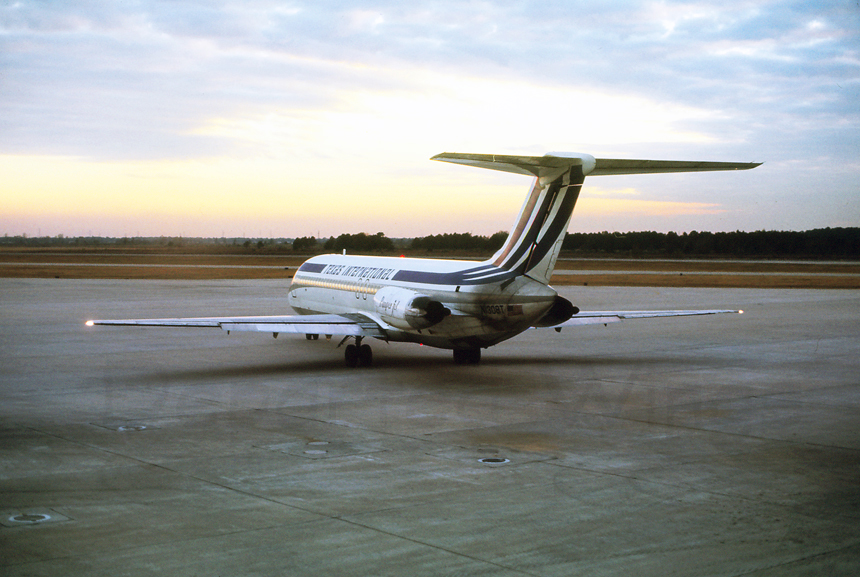
| November
1970 Houston's own based "local service" airline Trans Texas Airways, had renamed itself Texas International in April 1969 to better define its expanded services and flights to Mexico. When the airline moved operations from Houston Hobby to Houston Intercontinental Airport in 1969, it would be the carrier with the most flights served from the new airport. Seen taxiing away from the terminal building for an evening departure is N1308T, a Douglas DC-9-31, delivered new to the airline in January 1969. |
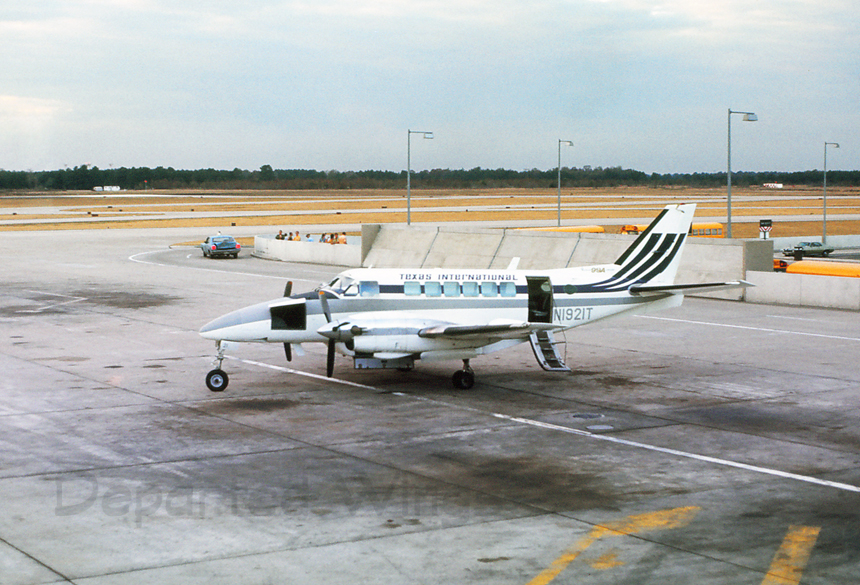
| December
1971 Trans During the late 1970s, many of the local service carriers faced a dilemma with the aging Douglas DC-3 and a replacement aircraft to serve smaller cities which did not support the larger turboprop or jet aircraft. The Beech 99 was introduced in March 1970 to replace the retiring DC-3 on serves to smaller eastern Texas cities from Houston including Galveston, Lufkin, Tyler, and Victoria. Seen parked on the ramp at Terminal A and awaiting loading for another flight is N1921T, a Beech B-99A, delivered new to the airline in February 1970. |
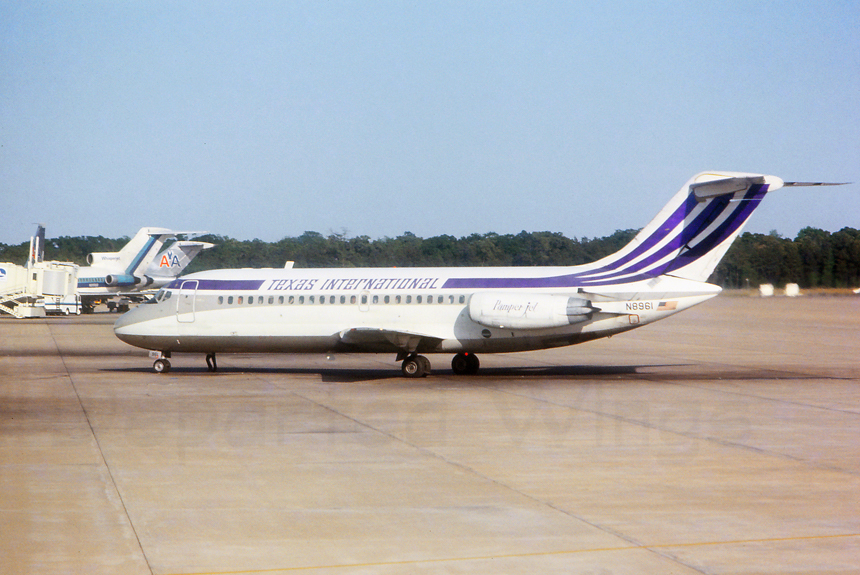
| April
1971 Trans Texas Airways introduced the Douglas DC-9 in October 1966 and introducing true "jet" service to many secondary cities across Texas. Affectionate known as "Pamper Jet's," Houston saw the twin-engine DC-9s in 1971, placed on "trunk" routes to Austin, Dallas-Fort Worth, New Orleans, and Baton Rouge, as well as on regional routes to Beaumont/Port Arthur and Corpus Christi. Seen having just been pushed back from "Terminal A" for an afternoon flight is N8961, a Douglas DC-9-14, originally delivered to Continental Air Lines in March 1966, and purchased by Texas International in May 1969. |
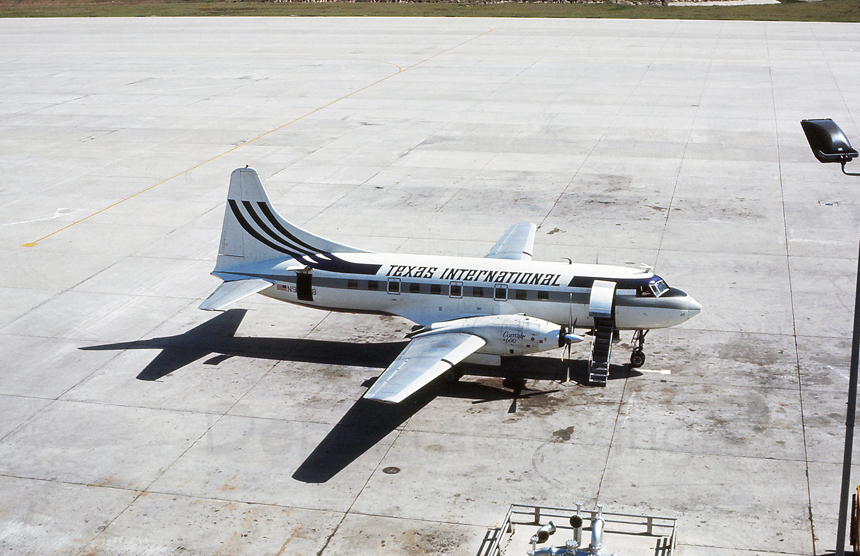
| April
1971 Trans Texas Airways decided to modernize its fleet of Convair 240 aircraft to "turboprop" power to effectively service smaller cities and communities in the route system. The first conversion to Convair 600 standards using a Rolls-Royce Dart turboprop engine was completed in 1965. The airline had eight Convair 600s, and used the aircraft on routes from Houston to Galveston and Beaumont/Port Arthur, Texas and Lake Charles and Lafayette, Louisiana. Seen parked on the tarmac and awaiting passengers for another flight is N94248, a Convair CV-600, originally delivered to Trans Texas Airways as a Convair 240-240-0, purchased from American Airlines. |
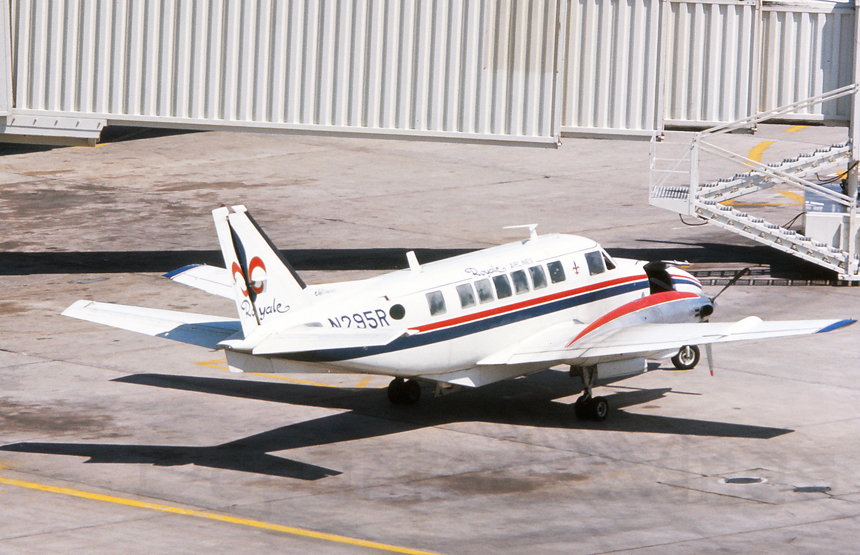
| May
1973 Based in Shreveport, Louisiana, Royale Airlines was started in 1968 to provide charter flights across the Gulf States and Texas with scheduled passenger flights starting on April 21, 1970. Using the Beechcraft B-99 turboprop flights were started to Houston Intercontinental in 1971 on services to Lake Charles, Louisiana. Parked at the terminal and awaiting its next load of passengers is N295R, a Beechcraft B-99A. |
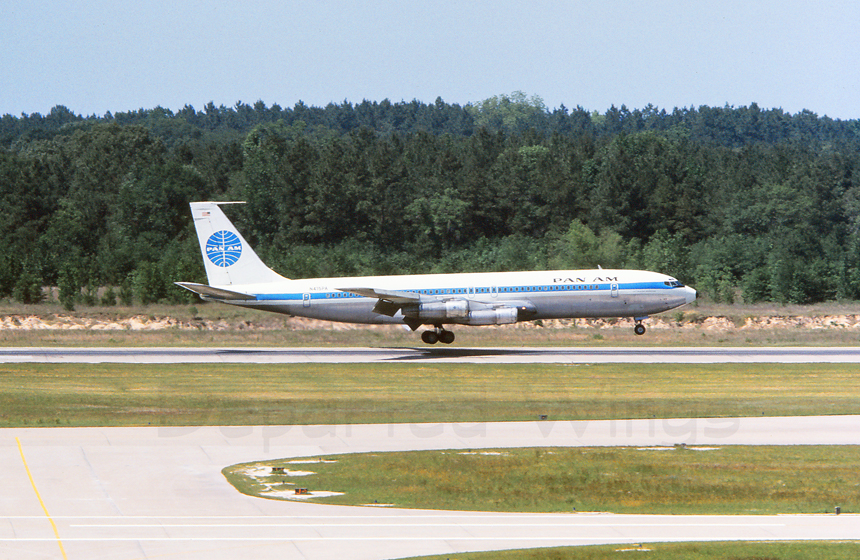
| May
1973 Pan American World Airways started service into Houston in 1947 with flights to Merida, Mexico and Corpus Christi, Texas. In 1949, non-stop service was started between Houston and Mexico City using a Douglas DC-4 and in 1961, Pan Am introduced Boeing 707 service on the route. By 1973, Pan Am's only flights to Houston was daily service to Mexico City using the Boeing 707. Seen just about to touch down on Runway 8 during an arrival from Mexico City is N415PA "Clipper Monsoon," a Boeing 707-321B, delivered new to Pan American on February 15, 1966. |

| May
1973 After Delta Airlines entered the Houston market in 1953, after the airline purchased Chicago & Southern Air Lines which had flights to New Orleans, Memphis, Beaumont/Port Arthur and Havana, Cuba. Delta eventually added non-stop flights to New York and introduced jet service in the early 1960s. By 1973, Delta had expanded considerable at Houston serving nine cities with twenty daily departures including flights to Atlanta, New York-JFK, and Shreveport. Seen taxiing toward the terminal complex after having landed is N458DA, a Boeing 727-232, having been delivered a week earlier to the airline on May 2, 1973. |

| May
1973 In 1972, Texas International Airlines was purchased by a new holding company, Jet Capital Corporation and introduced a new color scheme which was more "Texas" in nature. The airline continued to be the largest operator out of Houston Intercontinental, its home base with over twenty-five daily departures to nine destinations including; Baton Rouge, Dallas-Fort Worth, Denver, McAllen, and New Orleans. Having just received taxi clearance and pulling away from the terminal for an afternoon flight is N1309T "City of Austin," a Douglas DC-9-31, delivered new to the airline in January 1969. |
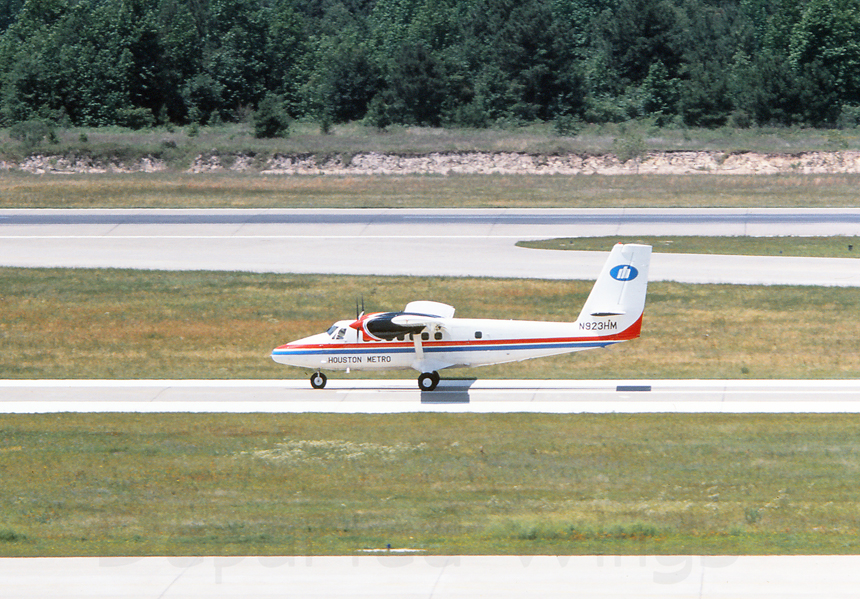
| May
1973 Houston Metro Airlines was a unique carrier that started operations in 1969 to provide service to NASA Johnson Space Center by constructing their own STOLport (Short Takeoff Or Landing) at Clear Lake City just adjacent to the the space center. Using a fleet of de Havilland DHC-6 Twin Otters, no less then twenty-five flights were scheduled round-trip between Houston Intercontinental and Clear Lake during the weekdays. A year later the airline started "cross-town" service to Houston Hobby from Intercontinental connecting the airports with a true "air-shuttle" service with fourteen daily flights. It is interesting to note, that one of the taxiways at Houston Intercontinental was designated a "STOL Runway" and was used by Houston Metro Airlines to reduce overall taxi and operational times. Seen rolling for takeoff on the STOL Runway is N923HM, a deHavilland DHC-6-200, delivered new to the airline on November 29, 1968. |

| May
1973 National Airlines started flights into Houston in 1956 with service to New Orleans, Tampa, and Miami using the Convair 340 or Douglas DC-7. At that time, Houston was the farthest stop west served by the airline. Eventually Houston became a hub for the airline especially on flights connecting to the West Coast. Seen taxiing toward the terminal after having landed is N4618 "Ruth," a Boeing 727-35, delivered new to the airline on September 24, 1965. |
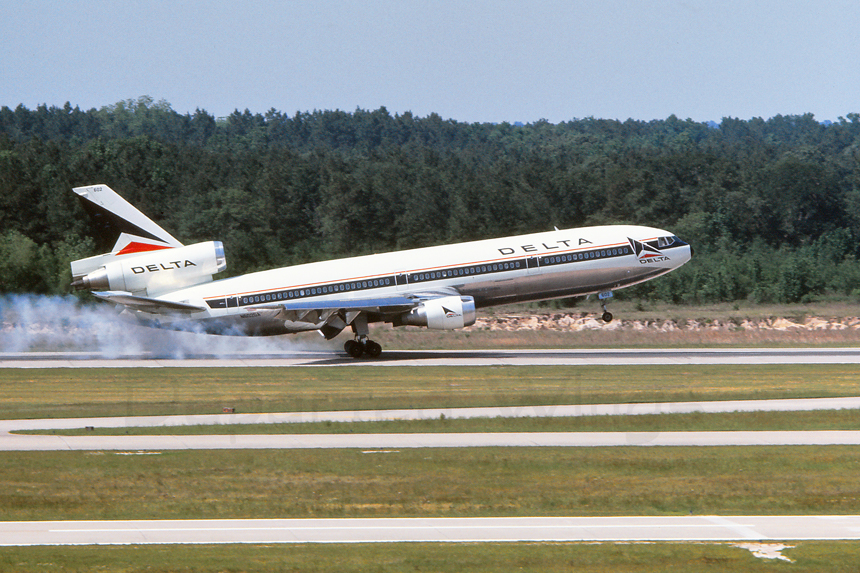
| May
1973 As many airlines looked to fill the void of the narrow-body and larger Boeing 747 gap, for trans-continental services, Delta settled on the Lockheed L-1011 by placing an order for the Tri-Jet in 1968. Concerned with potential setback with the L-1011 program and Rolls Royce engine woes, Delta ordered five Douglas DC-10 aircraft as a stopgap ensure and to remain competitive in the market. With a configuration of 250-passnegres, Delta's first Douglas DC-10 was put into service on December 15, 1972. Considered a larger market, Houston saw the DC-10s placed on the trunk Houston-Atlanta route. Seen "smokin' the tires" while landing on Runway 8 after a flight from Atlanta is N602DA, a Douglas DC-10-10, delivered new to the airline in November 1972. |
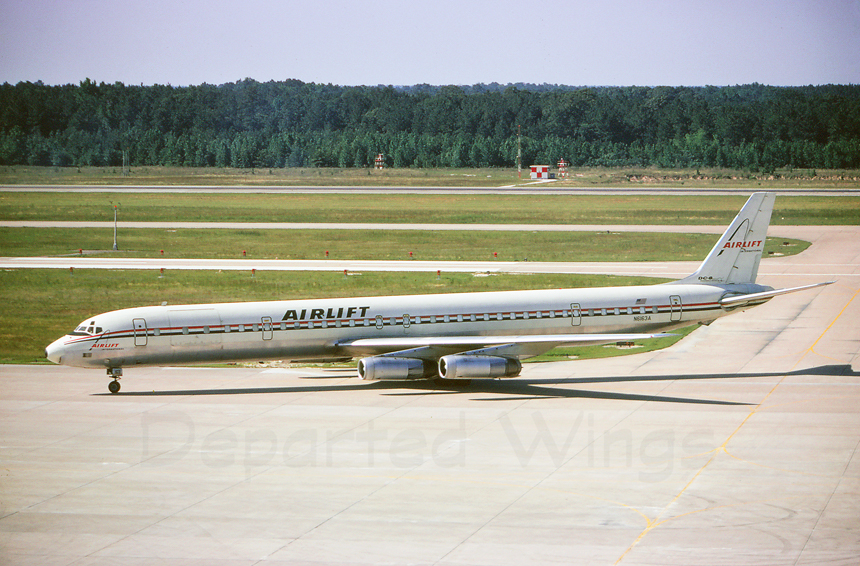
| May
1973 Airlift International Airlines was a Miami, Florida based cargo and freight airline that provided bulk cargo scheduled services across the United States and Puerto Rico. Cargo only jet service was provided with Boeing 707s, 727s, and Douglas DC-8s. With a large cargo market in oil drilling and astro-space related freight, Airlift had daily flights to Houston from Atlanta, Dallas-Fort Worth, and Los Angeles using both the Boeing 727 and Douglas DC-8 freighters. Seen taxiing toward the cargo ramp after having landed on a bright spring afternoon is N6163A, a Douglas DC-8-63CF. |
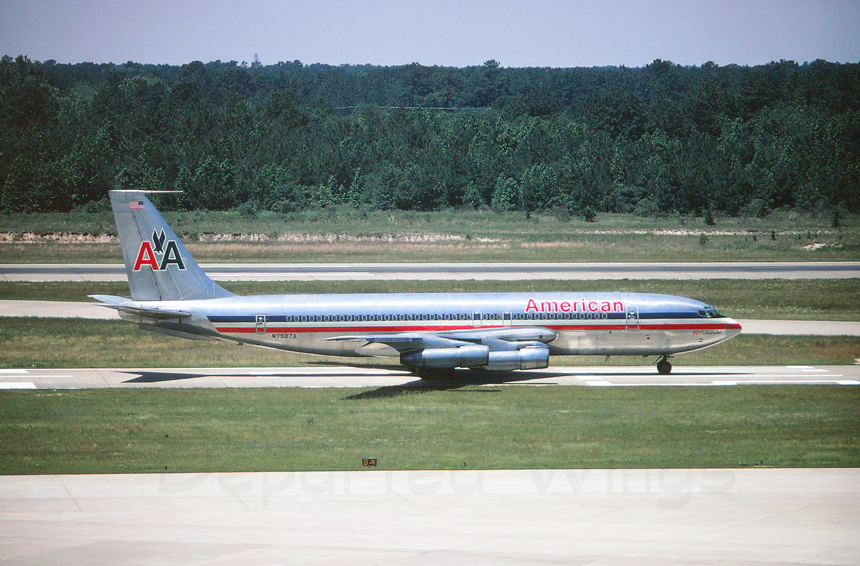
| May 1973 American Airlines started service into Houston in 1957 with a single daily flight to Nashville, Tennessee using a Douglas DC-7. With the move to Houston Intercontinental, American expanded its operations, adding flights to San Francisco, and St Louis. By 1973, Pittsburgh and Cleveland were also added to the Houston timetable using both the Boeing 707 and Boeing 727 on the various flights. Seen taxiing outbound for takeoff is N7587A, a Boeing 707-123B, delivered new to the airlines on July 7, 1967. |

| May 1973 Eastern Air Lines was an early operator to Houston when services were started in 1937 to New Orleans via Beaumont/Port Arthur and Baton Rouge, using a Douglas DC-3. During the 1950s Eastern would expanded at Houston adding regional flights to both San Antonio and Corpus Christi as well as non-stop services to Washington D.C. With the move to the larger Intercontinental Airport, Eastern Airlines made Houston a focus city and added flights to Atlanta, New York-La Guardia, and Newark. Seen taxiing toward its gate at Terminal A, Flight Station 4 after having landed, is N8849E, a Boeing 727-225, delivered new to the airline on November 17, 1970. |
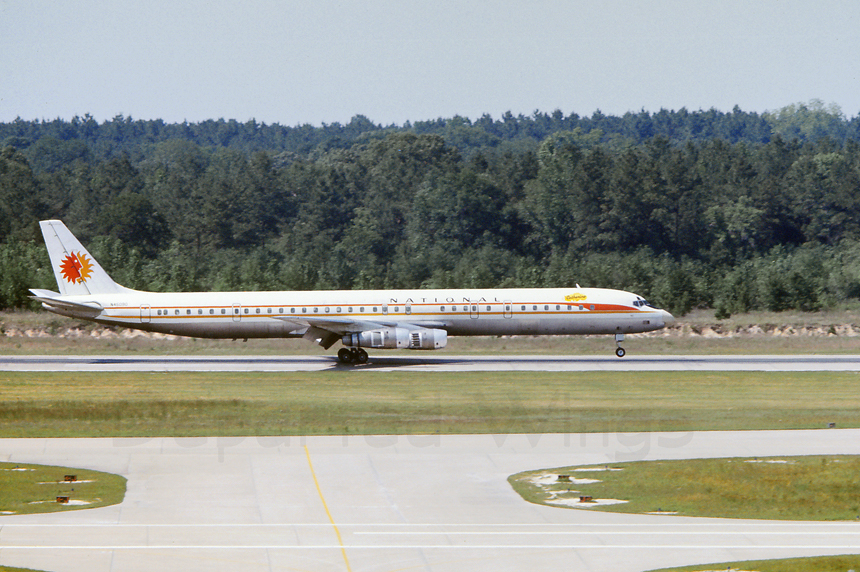
| May 1973 In 1961, National Airlines was awarded the Southern Transcontinental route case buy the Civil Aeronautics Board (CAB). The routes included the lucrative destinations along the West Coast including both San Francisco and Los Angeles. Houston would be one of the key cities providing non-stop flights to San Diego, Los Angeles, Las Vegas, and San Francisco initially with the Lockheed Electra. Eventually Douglas DC-8s replaced the Electra flights and after the move to Houston Intercontinental, National Airlines Douglas DC-8s were still being used on flights to Las Vegas and San Francisco, as well as on services to New Orleans. Seen touching down on Runway 8 is N45090 "Catherine," a Douglas DC-8-61. |
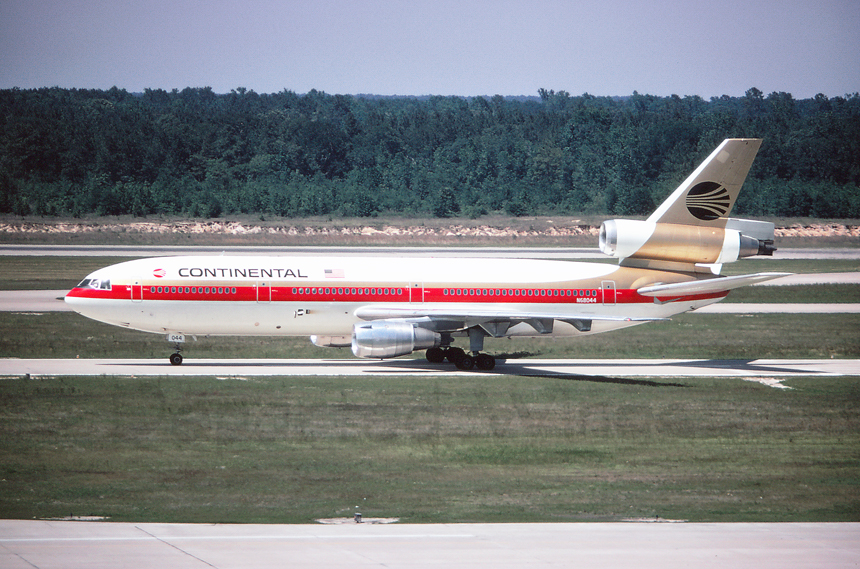
| May
1973 Continental Air Lines started operations at Houston in August 1951 on a single route to San Antonio using a Douglas DC-6. During the early 1960s, Continental added service to Austin, as well as non-stop "Golden Jet" services to Los Angeles using the Boeing 707. With the opening of Houston Intercontinental, Continental Airlines had room to expanded and by 1973 was serving nine destinations from Houston, including using its "Heavy 10s" on trunk routes to Denver and Los Angeles. Seen taxiing toward the the gate at Terminal A after having landed is N68044, a Douglas DC-10-10, delivered new to the airline on June 6, 1972. |
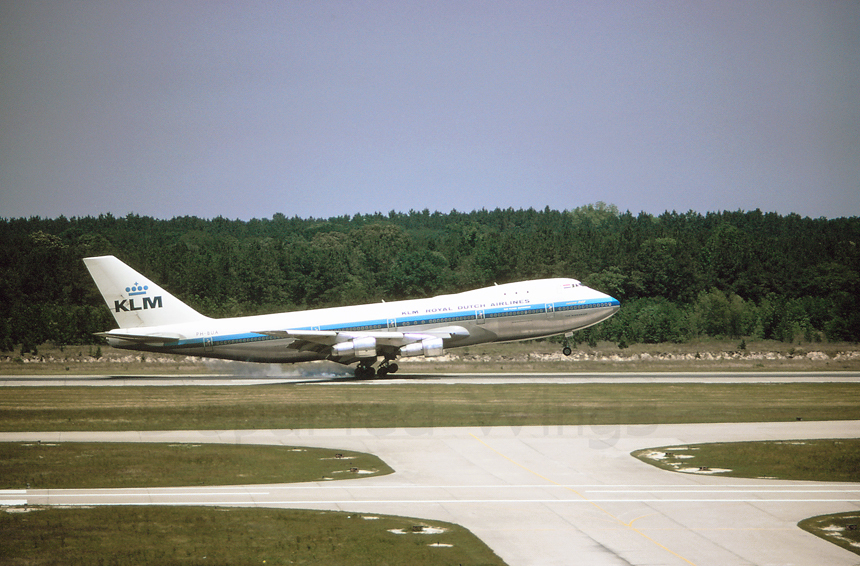
| May 1973 KLM Royal Dutch Airlines was the first international airline to start service to Houston when flights were started in 1957 to Amsterdam via Montreal using a Douglas DC-7C then continuing onto Mexico City. Douglas DC-8 jets replaced the piston driven Douglas DC-7 in the early 1960s. With the opening of the larger Houston Intercontinental and longer runways, KLM was able to start services to Houston using their new Boeing 747s in September 1971. Seen just touching down on Runway 8 during an arrival from Mexico City is PH-BUA "Mississippi," a Boeing 747-206B however the shorter runways at Houston Hobby imposed |
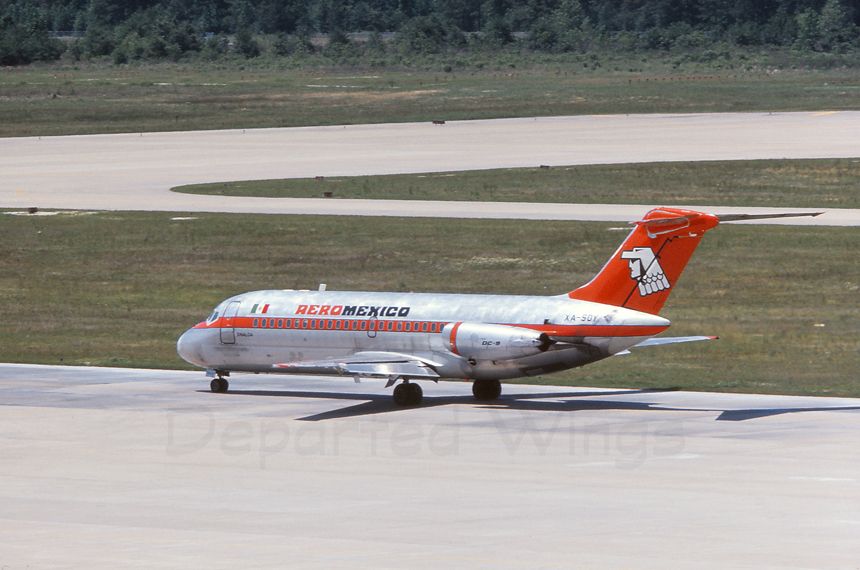
| May
1973 The second international airline to start service to Houston was Aeronaves de Mexico, later Aeromexico when flights were inaugurated in 1967 to Monterrey, Mexico, using the Douglas DC-9. With the move to Houston Intercontinental in 1969, additional service to Guadalajara was added. By 1973, Aeromexico had daily departures to Guadalajara, Merida, and Monterrey using the Douglas DC-9. Seen taxiing away from the terminal ramp for an afternoon departure is XA-SOY "Sinaloa," a Douglas DC-9-15. |
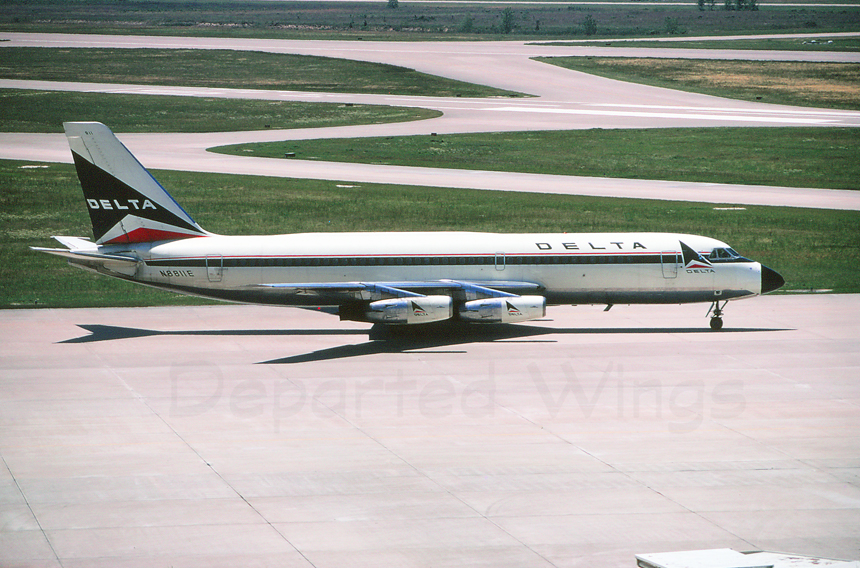
| May
1973 Delta Air Lines was the first airline to start jet service into Houston when Douglas DC-8s were introduced on the Houston-New York flights on December 1, 1959. When Delta Air Lines took delivery of its first Covair CV-880 "Hot-Rod," the airline used Houston to inaugurate the world's first Convair 880 schedule passenger flight to New York-Idlewild Airport on May 15, 1960. Eventually the Convair 880 would provide services from Houston to Chicago and St. Louis in addition to its New York flights. By 1973, although still being used from Houston to New Orleans and Atlanta before being retired from service a year later in 1974. Seen taxiing outbound for takeoff is N8811E, a Convair CV-880-22-2, delivered new to the airline in August 1961. |
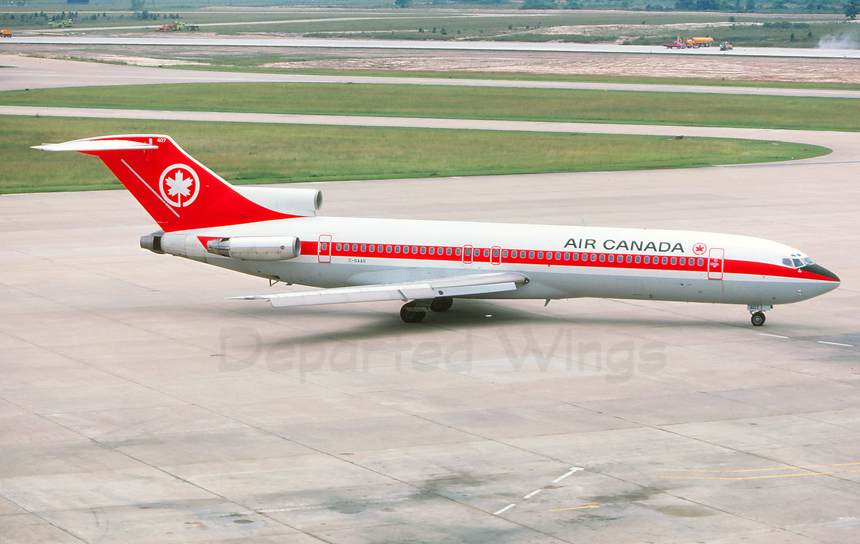
| July
1975 Houston was one of the fastest growing cities in United States during the 1970s and as such the popularity for international services grew as well. Air Canada started service to Houston-Intercontinental as an extension of its Toronto-Dallas service during May 1975. Seen taxiing into the gate at Terminal A is C-GAAC, a Boeing 727-233, delivered new to the airline on October 17, 1974. |
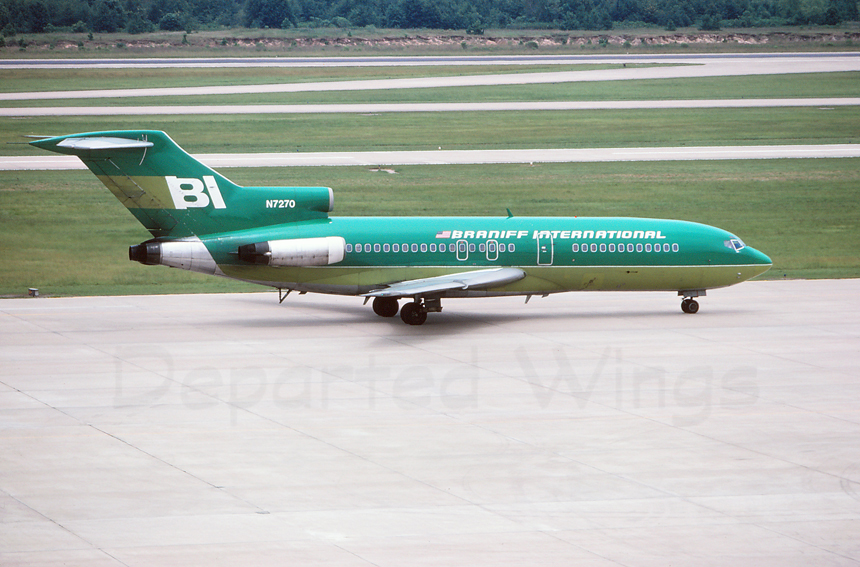
| July
1975 Braniff Airways was one of the first airlines to start passenger service into Houston when flights commenced to Dallas via Fort Worth, Waco and continuing on to Galveston in 1935 using a Lockheed Vega aircraft. Braniff International Airways then became the first airline to start international service from Houston in June 1948, when flights were started to Havana, Cuba, continuing to Panama thence to South America. Braniff Boeing 707 were introduced in April 1960 on flights to Dallas-Love Field. With the move to Houston Intercontinental, Braniff was serving six domestic destinations as well as international flights to Panama City, Panama all with Boeing 727 aircraft. Seen wearing the green "Flying Colors" and taxiing out for takeoff on a balmy summer afternoon is N7270, a Boeing 727-27C. |
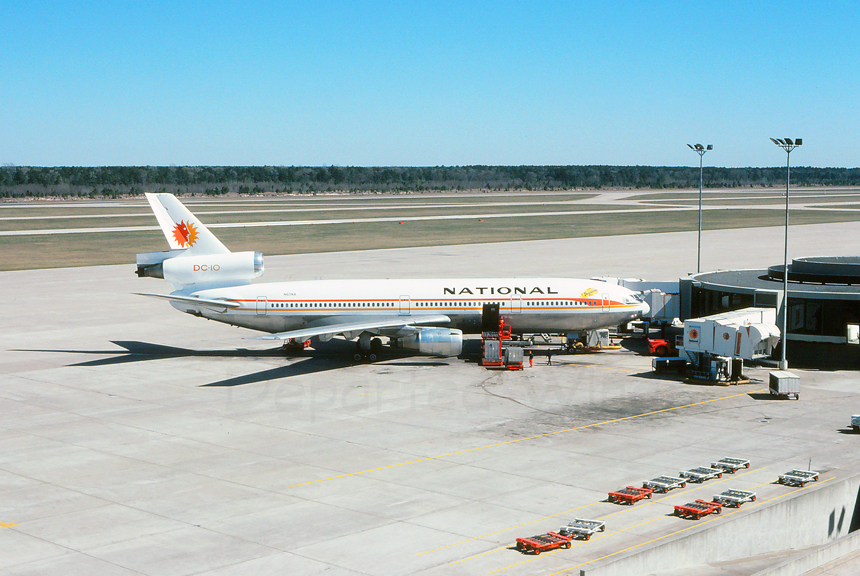
| February
1976 National Airlines ordered nine Douglas DC-10 aircraft in 1969, with a capacity of 256-passengers. The new-wide body Douglas tri-jets would be used to phase out the Douglas DC-8 and provide both transcontinental and high-density flights along the popular New York-Florida corridor. National's first DC-10 scheduled service started in January 1972, initially between Florida and New York, and then soon on other trunk routes in the system. National used their Douglas DC-10s extensively from Houston during the 1970s on flights to Los Angeles, Miami, New Orleans, and Tampa. Seen parked at the gate at Flight Station 2, Terminal A, is N60NA "Suzanne," a Douglas DC-10-10, delivered new to the airline on November 1, 1971. . |
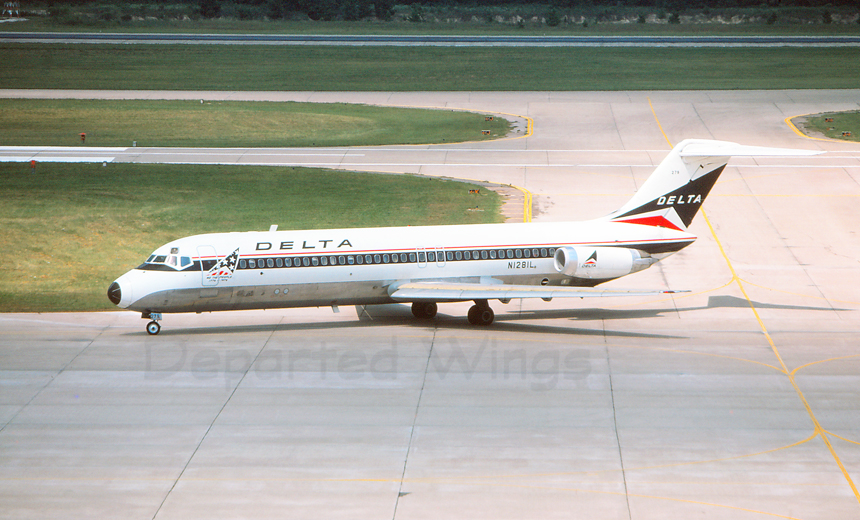
|
September
1976 Delta Air Lines was the first airline to inaugurate Douglas DC-9 service on December 8, 1965. The new "Twin-Jet" would replace the Douglas DC-6 and DC-7s on short and medium length segments. During the mid-1970s, Delta used the Douglas DC-9s on flights from Houston-Intercontinental to Little Rock, New Orleans, and Shreveport. Seen taxiing toward the terminal after having landed is N1281L, a Douglas DC-9-32. This aircraft, twenty years later, was the same involved in the fatal ValuJet Airlines crash in the Florida Everglades on May 11, 1996 operating as N904VJ. |
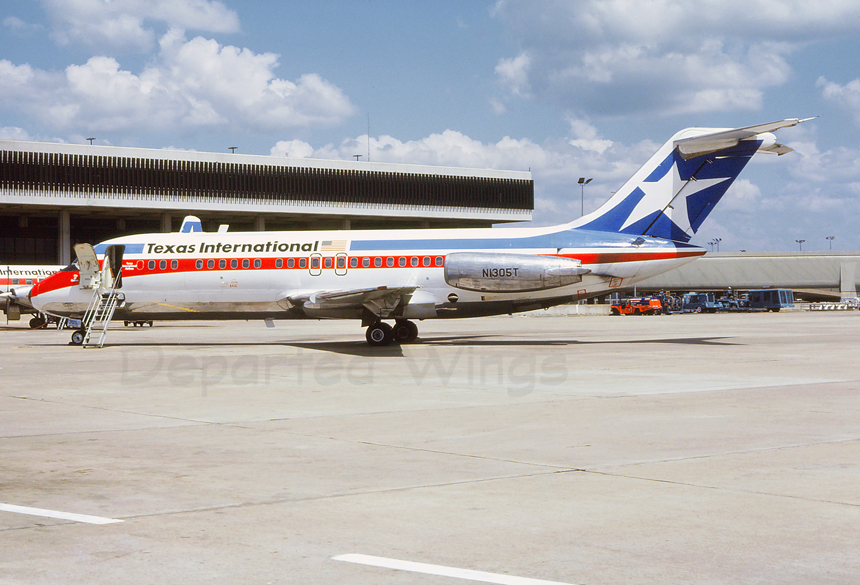
|
September
1976 By 1976, Texas International called Houston home and was the airline operating the most jet flights daily from the airport with over forty and service to thirteen different destinations (commuter carrier Metro lead in number of daily flights). Non-stop flights to Dallas-Ft. Worth were the "milk-run" for the airline with no less then ten daily departures. Parked on the ramp at Terminal A and awaiting passengers is N1305T "City of McAllen," a Douglas DC-9-15MC, one of five Douglas DC-9s in a "Mixed Cargo" configuration ordered by the airline. |
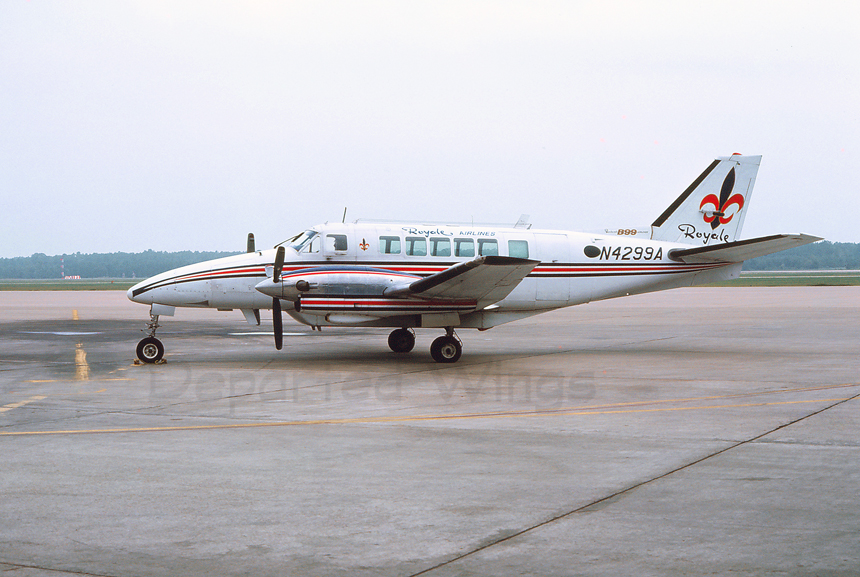
|
September
1976 Royale Airlines continued to provide commuter service to Houston-Intercontinental providing daily flights to both Shreveport and Lake Charles, Louisiana. Seen parked on the ramp is N4299A, a Beechcraft B-99, purchased by the airline in August 1975. |

| May
1978 Aeromexico continued to expand at Houston and by 1978 had added additional service to the resort destinations of both Cancun and Cozumel. With five Mexican destinations being served from Houston-Intercontinental, the airport had the most destinations served from the United States for the airline at the time. Seen taxiing to the terminal after having landed is XA-DEK "Guerrero," a Douglas DC-9-32, delivered new to the airline on February 19, 1974. |

| February
1979 Midwest Air Charter was a contract air cargo carrier that focused on overnight flying of parcels and bank notes for the U.S. Federal Reserve. After the cargo airline deregulation act was signed in 1977, Airborne Freight Corporation contracted overnight cargo services with Midwest Air Charter under the "Charter Express." Seen taxiing away from the cargo ramp for an afternoon departure to Wilmington, Ohio is N904MW, a Sud Aviation SE-210 Caravelle VI-R, converted to a freighter and delivered to Midwest Air Charter on November 17, 1978. |
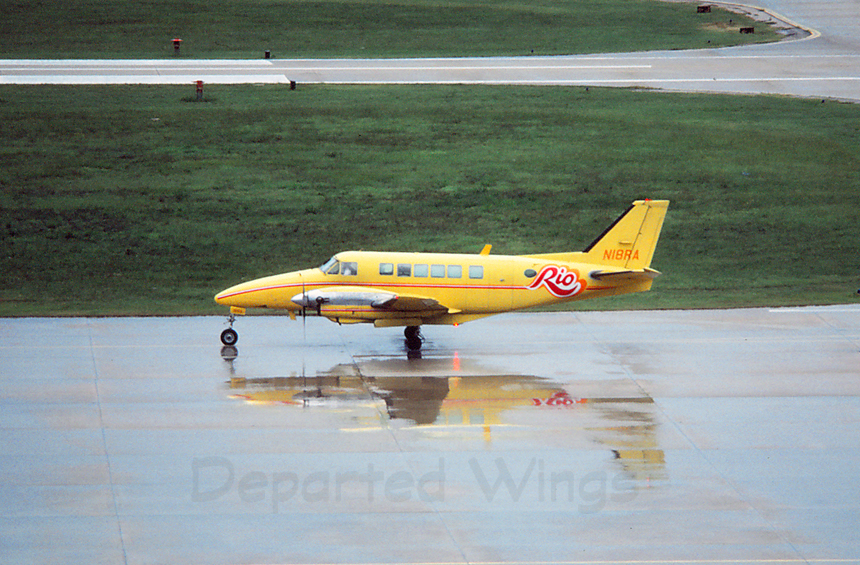
| July
1979 Rio Airways was a commuter carrier that started operations in 1966, from a base at Corpus Christi, Texas to points in southeast Texas using Beech 99 aircraft. Flights to Houston-Intercontinental started in 1979, with multiple daily flights to College Station, continuing on to Dallas-Ft. Worth. Seen taxiing to the terminal after having landed during a summer rainstorm is N18RA, a Beechcraft B-99A. |
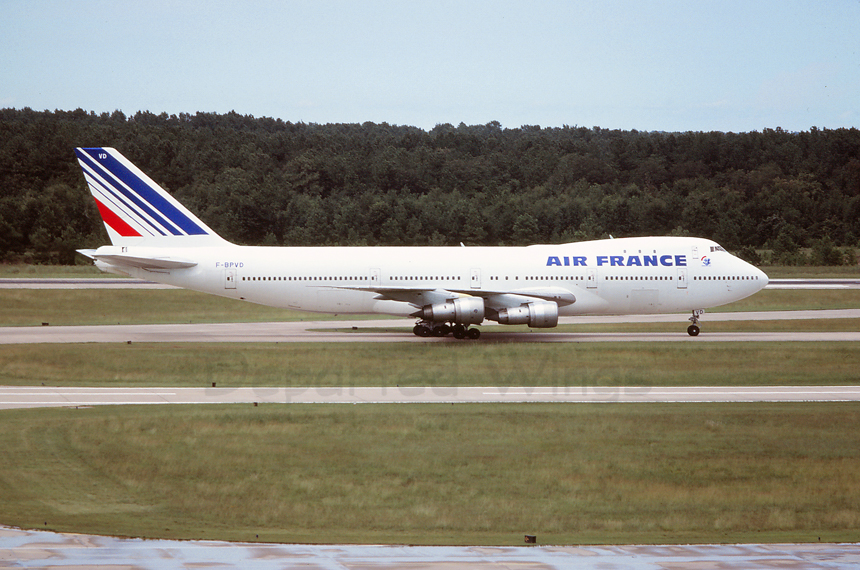
| August
1979 Air France started service to Houston on flights to Paris via New York in 1962 initially using the Boeing 707. Within a few years flights were halted but started again in 1973 using the Boeing 747 on four weekly flights with Houston-Intercontinental as a stopover on the Paris-Mexico City route. Seen taxiing outbound for an afternoon departure to Mexico City is F-BPVD, a Boeing 747-128, delivered new to the airlines on July 14, 1970. |
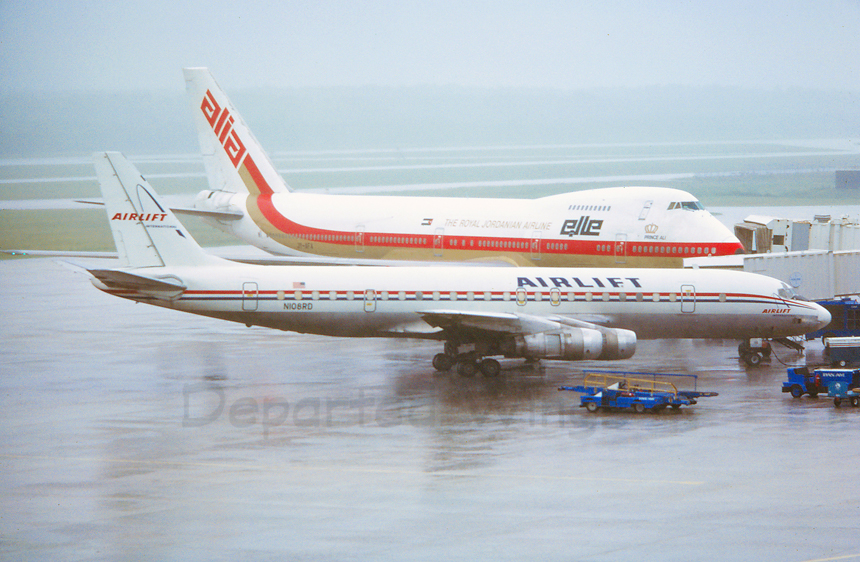
| August
1979 Terminal B and Flight Station 6 handled the international flights at Houston-Intercontinental during the 1970s. Seen during a summer rain storm is, N108RD, an Airlift International, Douglas DC-8-54F on a charter flight, with an Alia Royal Jordan Airlines Boeing 747-200 being readied for pushback. |
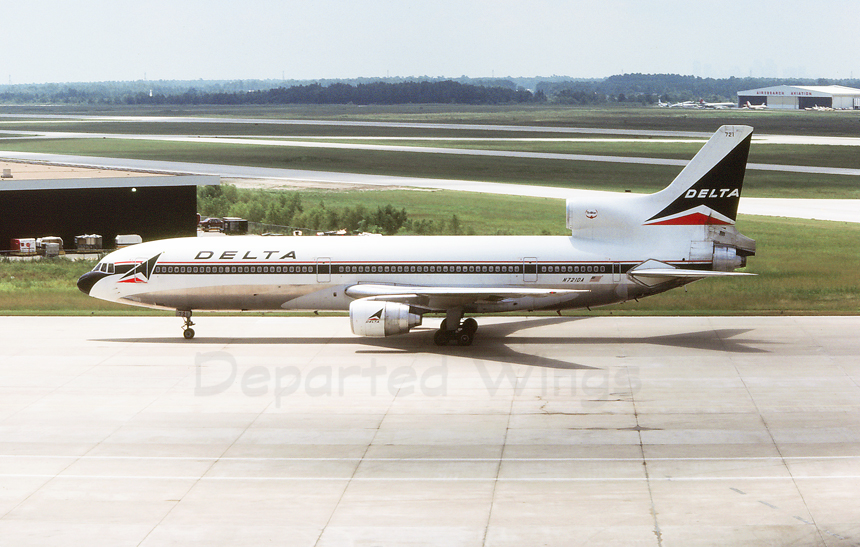
| August
1979 Delta Airlines inaugurated service with the Lockheed L-1011on December 15, 1973 with a flight from Atlanta to Philadelphia. Houston-Intercontinental was an early city with L-1011 service when flights were started in 1974 to both Atlanta and New Orleans using the new "Tristars." By 1979, Chicago-O'Hare was also being served with the 250-passenger L-1011s. Seen taxiing along the outer apron on a bright summer morning is N721DA, a Lockheed L-1011-1 Tristar. |
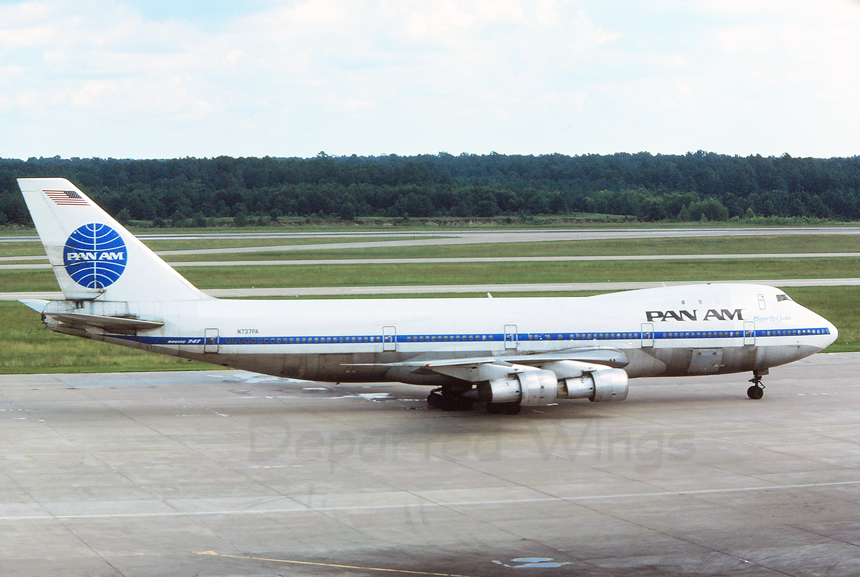
| August
1979 Pan Am introduced Boeing 747s to Houston-Intercontinental in 1978 as an additional routing to its Boeing 707 Mexico City service. The 412-seat "Jumbos" were used on a daily New York-JFK-Houston-Mexico City route. Seen taxiing away from the terminal for a 1:00pm departure to New York-JFK, is N737PA "Clipper Red Jacket," a Boeing 747-121, delivered new to the airline on January 21, 1970. |

| August
1979 Local service airline North Central Airlines, started service in Houston-Intercontinental in December 1978 with non-stop service to Detroit. Only six months later, would North Central merge with Southern Airways to become Republic Airlines in July 1979. Republic took the opportunity to expand at Houston, adding flights to Chicago as well. Seen having just been repainted in the new Republic colors and taxiing away from the terminal for an afternoon flight is N777NC, a Douglas DC-9-51, delivered new to North Central Airlines a few months earlier on June 22, 1979. |
Back to: The Airports